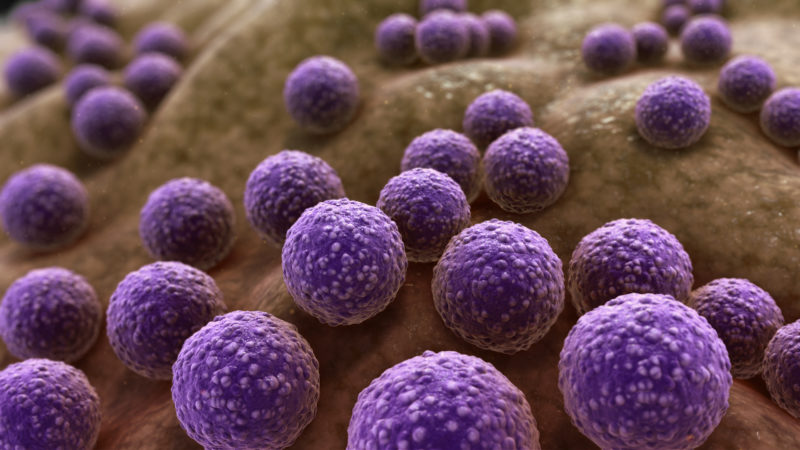Fighting Superbugs

Whittlesea Tech School calls on superheroes to fight superbugs. In this case, the superheroes are Victorian secondary school students. Students are invited to undertake an investigation: to develop antimicrobial products that kill nasty bacteria while keeping the good, innocent ones safe.
People learn about harmful germs and can make the assumption that all bacteria and viruses are out to get us. Yet each of us houses a thriving ecosystem of microbes, including bacteria and viruses, called our microbiota. Microbes live on our skin, in our airways, and in our digestive system, protecting us from harmful “invaders” (pathogens). Whittlesea Tech School’s Biotechnology in Focus Program teaches the relationships we have with microbes – both good and bad.
Our microbiota is the first line of defence against pathogens. By occupying space and taking up nutrients along our barriers, harmful pathogens have fewer resources with which to grow and cause disease. Our microbiota also fine-tunes the immune system. The constant presence of microbes keeps the immune system on alert so that it can rapidly respond if any pathogen slips through the barriers to cause infection and also ensures that the immune system does not over-react to cause excess pathology. Beneficial bacteria also can perform tasks that our cells cannot, such as metabolising nutrients that we cannot digest into useable molecules for our cells.
When good bacteria are eliminated, the immune system becomes dysregulated and disease-causing bacteria are given a chance to flourish. The result can be infection and autoimmune diseases, such as inflammatory bowel disease. Whittlesea Tech School therefore encourages students to consider the importance of bacteria early on, as it can be harmful to eliminate microbes that keep us healthy. Courses of antibiotics affect the gut microbiota, allowing pathogenic bacteria to colonise the gut (which is why probiotics are often recommended following antibiotics). Clostridium difficile is an example of an opportunistic pathogen that causes disease following antibiotic treatment and is the leading cause of hospital-acquired (nosocomial) infectious diarrhoea. It is therefore important when designing antimicrobial agents to only target those that cause disease – otherwise we can make things worse.
Over the course of a term, students enrolled in the pilot program were guided through a design thinking process to create and market a new antimicrobial product. Antimicrobial resistance threatens our ability to effectively treat an ever-increasing range of infectious diseases. Over 700, 000 people die annually due to drug-resistant infections because their diseases simply become untreatable. Adding to the toll is shortage of new antibiotics; pharmaceutical companies do not want to invest in drugs that are complex to develop and might not work several years down the track. Because of this, no new classes of antibiotics have been invented for decades – any new antibiotic is simply a variant of existing drugs discovered prior to 1984.
Students at four partner schools took to the challenge of producing their own antibiotics. Students were invited to walk in the shoes of a scientist to create their own serums that could fight bacteria (i.e. homemade concoctions made of wasabi, lemon juice, turmeric, vinegar, etc.). The important challenge was that the serum would ideally kill pathogenic bacteria but not normal gut flora. Students cultured bacteria samples in the Melbourne Polytechnic laboratories to test their solutions. The two bacteria selected were Lactobacilus acidophilus, found in the intestine, and Escherichia coli, which is also common in the gut, but there are some harmful strains that cause diarrhoea (e.g. traveller’s diarrhoea). The students’ goal was to design a product that could kill E.coli but leave L.acidophilus unharmed. Once they had developed something that worked, the next phase of the “design sprint” was to propose a product incorporating their antimicrobial solutions (e.g. Band-Aids infused with antibiotic extract and health tonics). Students then had to make prototypes and pitch their ideas to their peers, who would decide whether or not they would invest, thereby seeing their product all the way through from design, testing, and commercialisation.
The Biotechnology in Focus Program is not only centred around scientific investigation, but also on building career awareness of the biotechnology industry. “Biotechnology is not an industry that is very well-known within Australia,” says Kathy Sacca, Director of Talent Development at CSL Behring. For the first time, CSL Broadmeadows opened its doors to 100 students in years 7-9, where students toured the laboratories and heard from the heads of the HR, Research, and Manufacturing divisions. It was a great opportunity for students to have their minds open to real biotechnology applications and jobs here in Melbourne that they were not previously aware of – many even commented that they are now considering a career in the biotechnology industry.
“I never knew much about biotechnology…and I think it’s amazing. I think it’s the way of the future,” said a student from Viewbank College. Students loved the program and took ownership of their research – continuing to work on their projects over lunch time and at home.
The Biotechnology in Focus program was co-designed by Whittlesea Tech School, partner schools, and CSL Behring. “We have Australia’s largest biotech industry on our doorstep,” says Sandra McKechnie, Director of Whittlesea Tech School. They are therefore making the most of their position and providing the link between industry and education to encourage enthusiasm in science and technology among students. Now, Whittlesea Tech School is looking to engage with different industry partners to build on the programs they are offering and provide more opportunities for students.
Biotechnologists are going to be required to solve the challenges that society will be facing in the future. “Tech schools are designed to prepare students for jobs of the future,” says McKechnie. Whittlesea Tech School is therefore committed to provide opportunities for students to innovate and prototype solutions to real world problem and challenges. The team is building on their programs cover different year levels and to incorporate different aspects of the industry. Students will be designing ways to feed the world and heal the world with biotechnology.
Catriona Nguyen-Robertson
